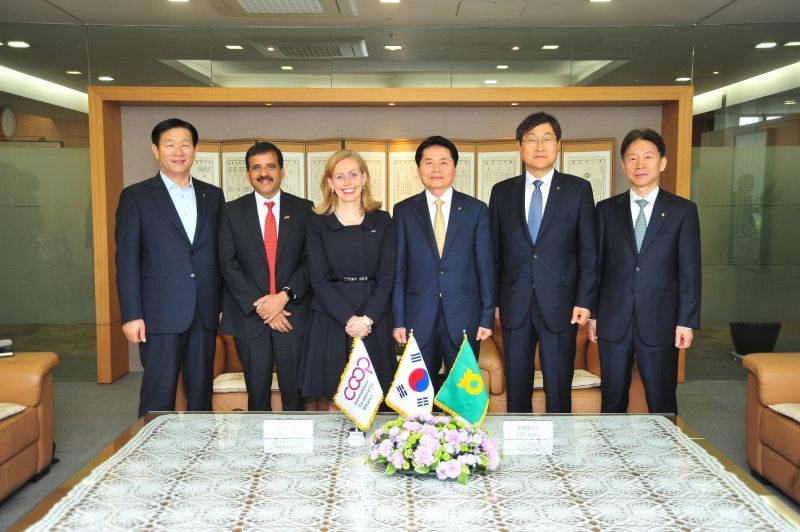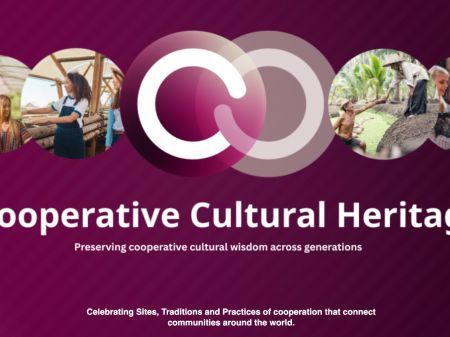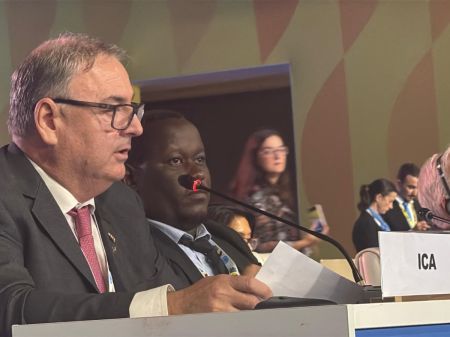
Article by Mr Balu Iyer, Director of the Alliance's Asia and Pacific Region
Traveling for four days through three countries (Japan, Korea and China) with the second International Cooperative Alliance (Alliance) woman President Monique Leroux was one exhilarating experience. The perks of traveling with the President is that you experience not only the red carpet laid out but also the opportunity it provides to hear directly about her vision for the Alliance and from the heads of leading cooperatives about their issues, concerns and actions they would like to see taken.
Japan – Land of Cooperatives
Day one began with an interview to reporters from the Ie-No-Hikari Association (the monthly for Japanese Cooperative Farmers started in 1925 and with a large circulation among women) and the Japan Agricultural News. The first question was around women and their role in cooperatives. Monique reiterated both the Alliance and her own commitment to the UN Planet 50-50 by 2030. While participation of both men and women was important; it was more important to adhere to the principle of no restriction, provide open access and impart full education. In response to a follow-up question about the difference having more women on the Desjardin board made, she said, “More women by definition means more young people. It brings in a whole new network and new connections. Men and women manage risk differently; more women means careful management of the organization. Diversity brings a better conversation to the table.”
The second stop was lectures by Monique and me on the direction of the Alliance and the Asia-Pacific region respectively to a group of researchers attending the spring seminar on cooperative research. Mr. Masahiro Higa, Executive Director, JA-Zenchu in his opening remarks lamented that cooperatives were not getting the recognition they deserved, despite their scope, volume and contribution to the economy. Co-operatives as a subject was taught in primary schools a number of years back, no longer; the government which played an active role in promotion of cooperatives, was now more of a combatant. Dr. Masaaki Ishida, Professor at Ryukoku University providing highlights of the seminar said the two issues discussed – the Trans Pacific Partnership Agreement which worked for interests of global corporations not local cooperatives and farmers; and looking closely into the fragmented legal framework for cooperatives in Japan as there was no common cooperative law and each sector was governed by a separate law.
Monique in her address spoke about the Blueprint for a Cooperative Decade and the strategic priorities coming out of it. These were to:1) Increase proximity and connectivity with members through the strength of local cooperatives and the Alliance’s global reach; improve member participation and communication; 2) Sustainable Development and education – international representation of cooperatives on global issues and on the UN SDGs with particular emphasis on social responsibility and sustainable development; promoting education on cooperatives and nurturing young leaders; and 3) Growth, trade and innovation – promote cooperative brand, innovation and collective entrepreneurship and partnerships and growth. She laid emphasis on the participation of cooperatives from Japan and Asia at the global platforms such as B20. The issues discussed in these platforms revolved around financial inclusion, jobs, food security, and sustainability. Cooperatives had a lot of value to add on these issues and needed to be heard. The other issues she touched upon were the need for innovation and better handling of data as they related to cooperatives. In my presentation I touched upon the need for engagement with regional bodies such as ASEAN and SAARC. As an example, the ASEAN Economic Blueprint mentions cooperatives under just one section, agriculture. The diversity and scope of cooperatives in ASEAN have not been acknowledged in a region where 10% (60 million out of 600 million) of the population are members of cooperatives.
A bullet train ride the second day morning, took us to Fukushima City in Fukushima prefecture. The Great East Earthquake on March 11 recorded magnitude 9.0 and caused extensive damage in the prefectures of Fukushima, Miyagi and Iwate. The earthquake and tsunami that followed triggered the worst nuclear accident since Chernobyl at the Fukushima Daiichi nuclear power station. An account of the Japanese cooperative movement’s response to rebuild lives can be found at: Working together helps rebuild lives and farms. According to Mr.Takashi Kanno, Union President, Fukushima Mirai Agricultural Cooperative Association, “our intent from the beginning was to look ahead and secure livelihoods. In 2010, much before the earthquake struck, we purchased land and started the Shinkfukushima farm to train and develop a new generation of farmers. This land has now come in handy.” An example we saw was the Feliz Latte dairy farm being set up to rehabilitate farmers who had lost their livelihood in the critical area. General Manager Ishibasi of the Shinkfukushima while sharing fresh cucumbers from the greenhouse said, “The farmer training program focuses on rice and vegetable cultivation. We bring together young people, train them and try to get them interested in farming as an occupation. The training program has acceptance from the local government and they are now sending people to get trained in farming.” We also got to see the radiation monitoring center set up by the Fukushima JA to ensure that food supplied at their retail stores is safe and secure. The monitoring ensures that radioactive levels of locally produced agricultural products are within levels, provides traceability and ensure produces reaching the consumer are safe for consumption.
In the afternoon we took part in a meeting with Japan Joint Committee for Cooperatives. This group consisting of all 15 ICA members from Japan was formed in 2012, the International Year of Cooperatives, to give a platform for cooperatives to come together and address issues of common concern. An idea now being mooted is the formation of an umbrella organization, the National Center for Cooperative Promotion. The meeting was attended among others by, Mr. Choe Okuna, President, Central Union of Agricultural Co-operatives; Mr. Katsumi Asada, President, Japanese Consumer Co-operatives Union; Mr. Yuzo Nagato, President, Japanese Workers’ Co-operative Union; Mr. Shinichi Maita, CEO, National Federation of University Co-operatives Association; Mr. Hiromi Katsumata, Managing Director, Japan Co-operative General Research Institute; Mr. Masanobu Yoshinaga, Senior Managing Director, National Federation of Agricultural Cooperative Association.
The program in Japan wrapped up with a courtesy call on Mr. Hiroshi Moriyama, Minister of Agriculture, Forestry and Fisheries, Government of Japan. Mr. Moriyama said he was very aware of the ICA principles and values and spoke of the need to respect autonomy of cooperatives. This was welcome, especially in light of the reforms being undertaken by the JA group. He was keen to hear about ICA’s campaign at global platforms for the recognition of co-operatives as a source of sustainable growth, quality employment and basis for food security. The last point resonated as the G7 countries meeting in Japan was focused on promoting agricultural innovation and investment as farmers face the twin challenges of an aging workforce and extreme weather at a time when global food demand is increasing.
Korean cooperatives - mark of local, safe, quality products
Day 3 started with a call on Mr. Byenog-Won Kim, the newly appointed Chairman of NACF. Mr. Kim in opening remarks expressed his commitment to cooperative values and principles and cooperatives as alternative voice for the vulnerable. He spoke about the need to improve income and boost productivity at the farm level and the distinctive role played by agriculture cooperatives, and in particular NACF. He was concerned the government was misunderstanding cooperatives and the autonomous character of cooperatives was being eroded. While the government had an oversight role to play, too much intervention and unnecessary meddling in the affairs of cooperative was coming in the way of good business functioning. He called on ICA to provide a global voice to stress with governments the importance of cooperative autonomy and self-help.
Monique in her speech to a large gathering of NACF staff reiterated the need for cooperatives to carry the message to governments that cooperatives were an important contributor to building community and people. The number one rank of NACF among agricultural cooperatives (number six in the World Cooperative Monitor 300), the 3 million farmer members, the 100,000 employees and $330 billion in assets were testament to the important role played by it in ensuring security for farmers and safe and quality products for the consumers. Monique spoke of the Alliance’s role to unite, promote and develop co-operatives. Given there were many in the audience from NongHyup Financial, she spoke about her experience in Desjardin and its path to becoming the 5th largest financial cooperative in the world. Following the financial crisis of 2008, Desjardin went through a thorough internal review and set new sights to transform itself to being a financial group that inspires trust through the commitment of its people, its financial strength and its contribution to sustainable prosperity. In doing so, it has stuck to its original mission to contribute to improving the economic and social well-being of people and communities and adhered to the Desjardins Group’s six permanent values of money at the service of human development, personal commitment, democratic action, integrity and rigor in the cooperative enterprise, solidarity with the community, and intercooperation.
The lunch at Korea House was attended by Ms. Inja Park, President, iCOOP; Mr. Byeong-won Kim, Chairman, NACF; Mr. Im-kweon Kim, President, NFFC; and Dr. Cheol-sang Moon, Chairman, NACUFOK. The Korea House is a place to experience various features of Korea traditional cultures including traditional foods, traditional performances and traditional wedding ceremonies. In response to a question about issues facing cooperatives in Korea, the three main ones bought up were autonomy of cooperatives, intercooperation and capital. Given the origins of co-operatives in Korea with government support, the oversight by government to this day went into minute details. An example given was the say government had in promotion of executives at NACF. The issue of intercooperation focused on relationship with members as owners. The issue of capital was similar to that faced by cooperatives in other countries that were desirous to grow and compete on a global scale. The challenges in attracting long-term funding on account of cooperative structure.
The visit to the Nonghyup Hanaro Mart Goyang Bra nch was an eye opener. Opened in 2001, it is one of the biggest distribution centers of agricultural and marine products offering variety of Nonghyup brand products from all over the country in addition to agricultural products of the area. The mart sells reliable agricultural products that are of good quality, fresh, and suitably priced. Walking around the store, signs could be seen where local products were emphasized and local producers acknowledged. In addition to physical stores, NACF has been expanding its online presence through the NHaMarket. The aim of the online mall is to connect farmers and co-operatives to customers. The market place had both B2C and B2B components. On the B2C side were the e-Hanaroclub where delivery from the nearest Hanaroclub was made the same day and the Food-bundle delivery where customized food was delivered. On the B2B side, in addition to agricultural input were the MRO shop (maintenance, repair and operation and delivery of office supply for NACF, member co-ops and subsidiaries) and the Restaurant Market (bulk sales for restaurant owners).
China – not surprised by inspired
On day four, the first visit was to the office of China E Coop, a national e-commerce platform supported by the All China Federation of Supply and Marketing Co-operatives (China Co-op) that was launched in November 2015. President Li Chunsheng in his introduction said, “the E-Coop was part of China’s Silk Road Economic Belt and 21st Century Maritime Silk Road initiative to promote rural e-commerce and provide cross-border electronic commerce.” As one enters the building, the bright orange logo G welcomes the visitor. The G, apart from being a letter (‘go to buy’) also signifies orange (symbol of freshness and health) and smiling face (to provide customers a pleasant experience). Also displayed in the lobby were an array of well packaged products that could be purchased online. The platform is meant to merge China Co-op’s traditional business and network systems and the internet to serve the rural, agriculture and farmer. The plan is to eventually link all of China Co-op’s 147,297 primary cooperatives, 340,000 rural service centers and 2,406 county level co-operatives to the network.
The meeting with members of the International Committee for the promotion of Chinese Industrial Cooperatives (ICCIC-Gung Ho) took place at the Peace Palace of the Chinese People’s Association for Friendship with Foreign Countries. This also happened to be the place where Rewi Alley, a New Zealander, lived and set up the Chinese Industrial Cooperative in 1937. The ICCIC these days develops cooperative organizations of all types and works to promote legislation and policies which enable cooperatives to thrive. Michael Crook, Liu Denggao and Yun Lin gave us a brief on the efforts underway to move away from the specialized law for farmers cooperatives developed in 2007 to a more generalized law for cooperatives. The need for the law to uphold cooperative principles, understanding of government administrators of distinction between cooperatives and corporations, emphasis on member education to ensure that a few did not dominate, member and non-member transactions, were all touched upon. Huang Feipeng, a young member of the farmers’ cooperative talked about the agriculture incubators in rural areas being set up for returning migrant workers. The incubator is a community supported activity to train the workers in agriculture, help in purchase and donation of equipment, develop the value chain and generate employment.
Our next stop was to the office of the All China Federation of Handicraft Industry Cooperatives (ACFHIC). Established in 1957, ACFHIC is a national collective economic organization formed by various sorts of collectives in urban and rural areas, industrial unions, handicraft industrial cooperatives and societies. Vice-President Wang Shicheng said that the sector had registered 7% growth last year and ACFHIC was focused on creating jobs, promoting entrepreneurship and supporting value-added services. To do this they were focused on 20 business sectors and interested in getting into providing financial services; an area where they wanted support. It came as a surprise for us to know that the Haier Group, a market leader in household appliances, was a collective.
The last official engagement was dinner with Ms. Wang Xia, President of China Co-op. She spoke of the role and responsibilities of cooperatives in China and their contribution to the economy, social development and livelihood. The recent reforms proposed by the government sought to infuse new vitality towards meeting the needs to the rural community. China Co-op which covers 80% of the rural areas had an important role to play through its supply and marketing network to modernize agriculture and improve the rural economy. Last year at China Co-op’s 60th anniversary celebration, President Xi Jinping congratulated their work and urged them to up their contribution. Ms. Wang reiterated ACFSMC’s commitment to ICA values and principles and continued support to the cooperative movement.
The highs and lows
There were many inspirational stories coming out from this visit which showcased cooperative response to member needs, innovation for better solutions and scale to magnify growth. The Feliz Latte milk farm in Fukushima and the incubation centers for returning migrant workers in Chengdu were examples of response to member needs. Farming is at the heart of the cooperative movement and it was exciting to hear efforts to keep the beat going. The commitment from Mr. Okuna of JA Zenchu and Mr. Kim of NACF to bring attention back to farmers, the efforts of Mr. Ishibasi to train young people in farming, and young people like Huang Feipeng (ex airline quality engineer for one) to set up agriculture incubators were all very exciting to hear. Building trust with the consumer and supporting local needs was very visible at the consumer stores in Japan and Korea. It was motivating to see the efforts taken by the cooperative in Fukushima to set up their own radiation monitoring center to ensure safe products reached the consumer and the wholehearted promotion of local farmers and locally produced goods in the Hanaro marts in Korea. It was breathtaking to hear the sheer scale and scope of the NHaMarket and the China E Coop platform to link the producer and consumer seamlessly.
The common concerns across the three countries were in terms of getting more attention of farmers and importance to farming; growing government interference and reducing space for cooperative autonomy; developing stronger intercooperation ties; and strengthening financial access for cooperatives.
So, what are my impressions traveling with the President? She is sharp, for sure. She likes to be prepared for any meeting (does not matter if it is a minister or a farmer). She doesn’t like surprises, especially when it comes to her schedule. She doesn’t hold back on questions till she gets to the heart of the matter. She is technologically and social media savvy and would like all cooperatives to come on board. Her passion is to inspire the young and get them on board the cooperative bandwagon. Her focus is on the cooperative business community to foster business development for all cooperatives, explore new markets and identify growth opportunities. This will go a long way in boosting the cooperative economy. One sure learns a lot traveling with her. I did!
The trip would not have been possible but for the efforts of Kenki Maeda and Ayako Nakata in Japan; Lee Beom-seok and Gwangseog Hong in Korea; and Zhang Wanghsu and Xiaohang Zhang in China. Thank you all!




